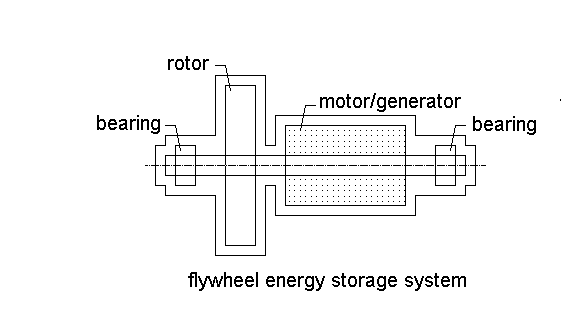Flywheel Energy Storage
Introduction
Flywheels are inertial energy storage systems. They were first used
in steam engines, in the 1970s this technology was used for centrifugal enrichment
of uranium and then rediscovered as a potential new energy storage system.
Flywheels store kinetic energy in a rotor; its diameter ranges from
a few inches up to several meters, and speeds up to 200,000 rpm. Usually
a generator/motor in- and outputs electrical energy to the flywheel.
Capacity
Flywheel energy storage systems have capacities from 0.5 kWh to
500 kWh. The energy stored is ½Jw², where J /
(kgm²) is the moment of inertia of the flywheel system and w / (rad/s)
is the angular velocity of the flywheel.
The flywheel itself loses less than 0.1% of the stored energy per hour,
if magnetic bearings are used. Thus, flywheels canít store energy for a
long period of time, but the energy stored in a flywheel systen can be
released in a relatively short period of time. This makes it very useful
for UPS (Uninterruptable Power Supply) systems and also for vehicles.
It acts as a mechanical battery.
Composition
The basic components are a rotor, a shaft, a vacuum housing, bearings,
and a generator/moter.
Electrical energy is necessary to drive the system. Ití is fed into
the motor which converts it into rotational energy. The energy
is stored in form of kinetic energy in the rotor. When energy is needed,
rotational power is taken out of the rotor and converted back into electrical
energy.
The rotor is made of material that has a high tensile strength and a low
density, e.g kevlar. Such a material is necessary because the kinetic energy
rises with the angular speed of the rotor, but only linear itís mass.
The bearings are usually magnetic bearings since no mechanical bearings
are available for such high angular speeds. In addition, the loss is lower.
Therefore also a vacuum housing is used. The shaft has no special requirements.

THE ALTERNATIVE ENERGY STORAGE GROUP:
Christoph Böhm TI4 TIW5CHBO@pcmail.rz.fht-esslingen.de
Gregor Lotti NT4 NTS5GRLO@rz.fht-esslingen.de
Patrick Lotti NT4 NTS5PALO@rz.fht-esslingen.de
